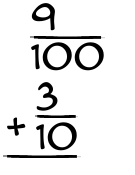What is 9/100 + 3/10?

|
This is how we add
|
|||||||||||
Step 1We have to make sure the denominators are equal. Since 10 is evenly divided by 100, we can multiply just one term to get a common denominator. Multiply 3 by 10, and get 30, then we multiply 10 by 10 and get 100. The problem now has new fractions to add:
|
|||||||||||
Step 2Since our denominators match, we can add the numerators. 9 + 30 = 39 This yields the answer
|
|||||||||||
Step 3The last step is to reduce the fraction if we can. To find out, we try dividing it by 2... No good. So next you try the next prime number, which is 3... No good. So next you try the next prime number, which is 5... No good. So next you try the next prime number, which is 7... No good. So next you try the next prime number, which is 11... No good. So next you try the next prime number, which is 13... No good. So next you try the next prime number, which is 17... No good. So next you try the next prime number, which is 19... No good. So next you try the next prime number, which is 23... No good. So next you try the next prime number, which is 29... No good. So next you try the next prime number, which is 31... No good. So next you try the next prime number, which is 37... No good. So next you try the next prime number, which is 41... No good. 41 is larger than 39. So we're done reducing. And we're done! Here's the final answer to 9/100 + 3/10
|